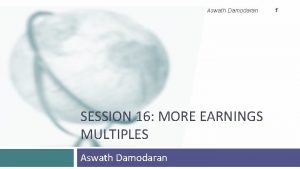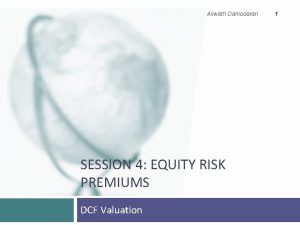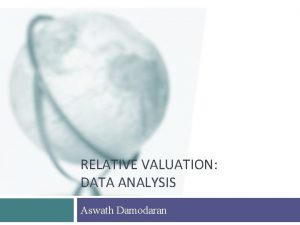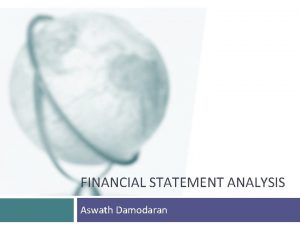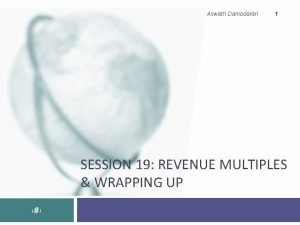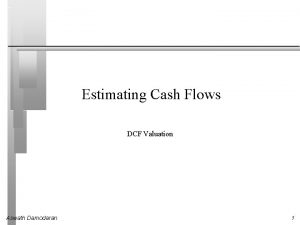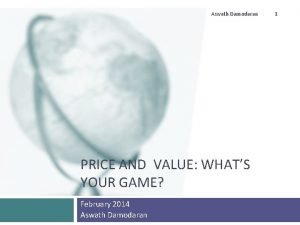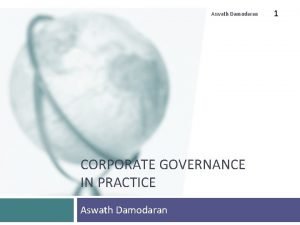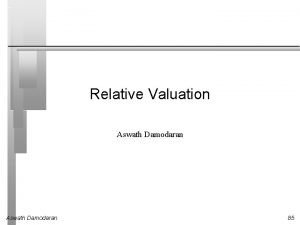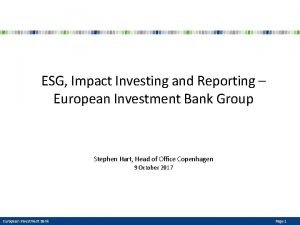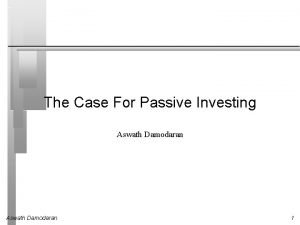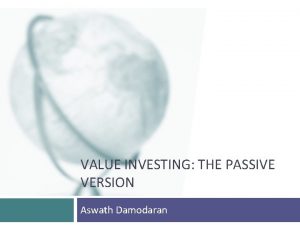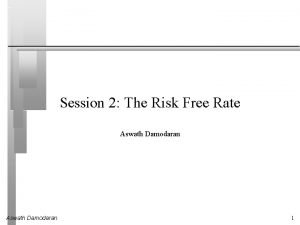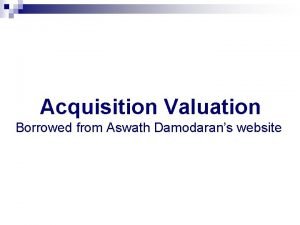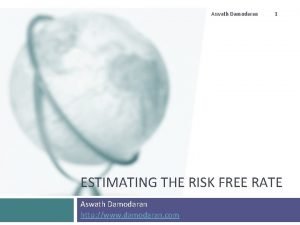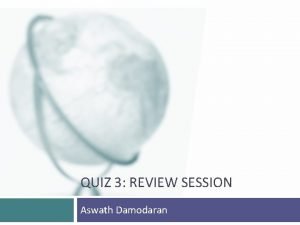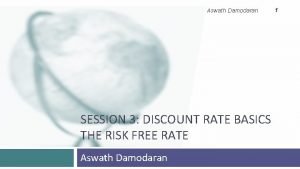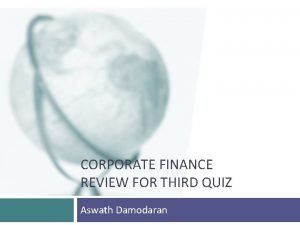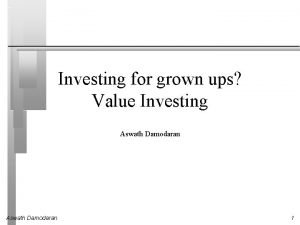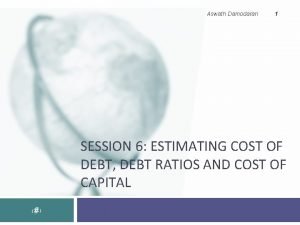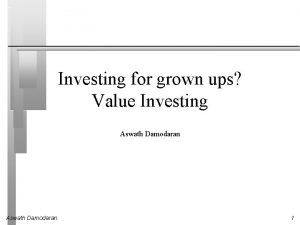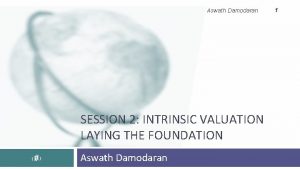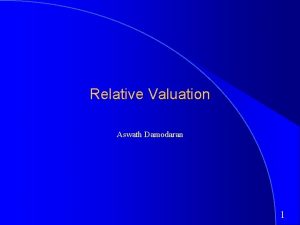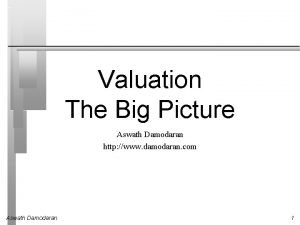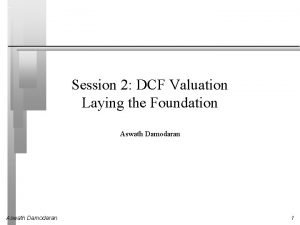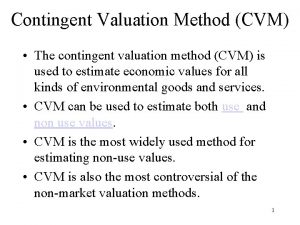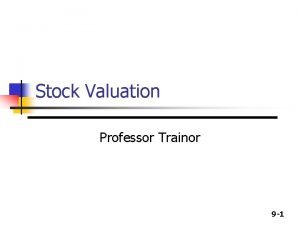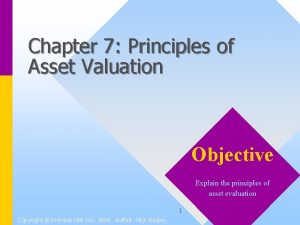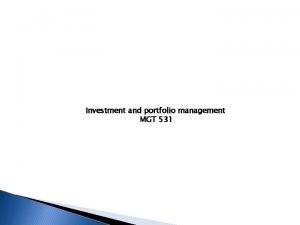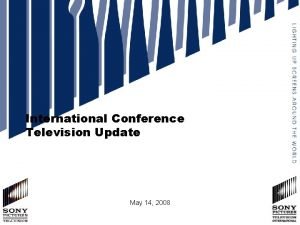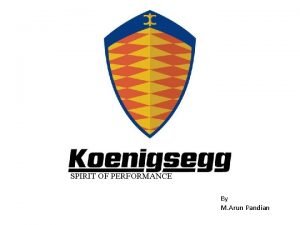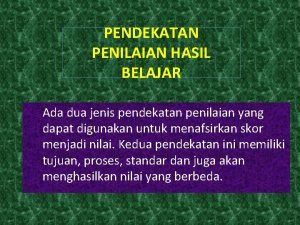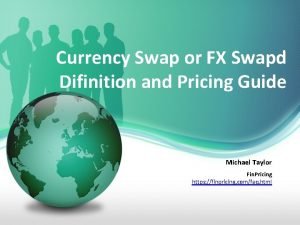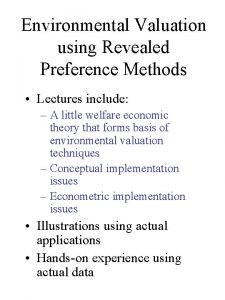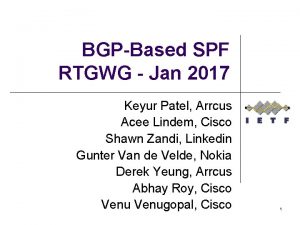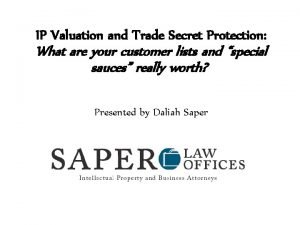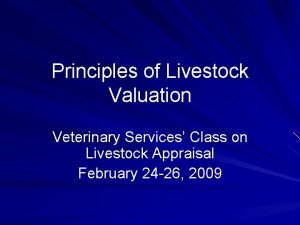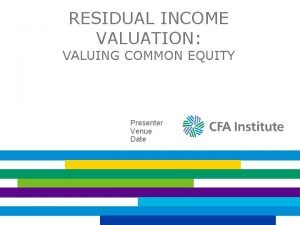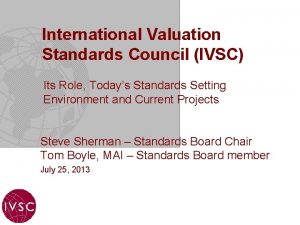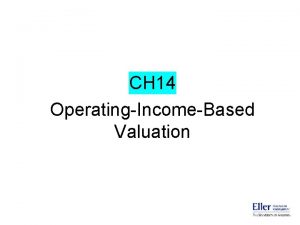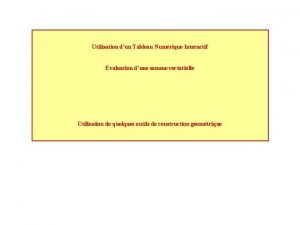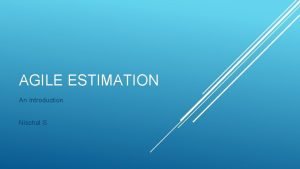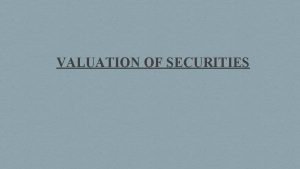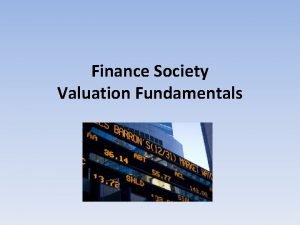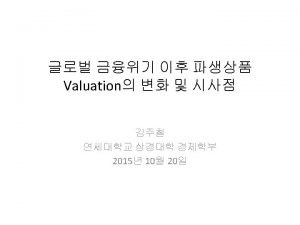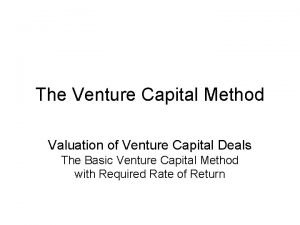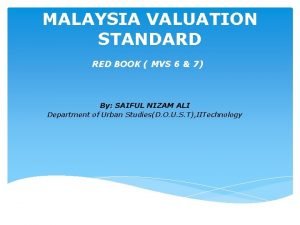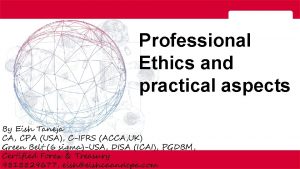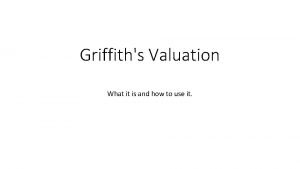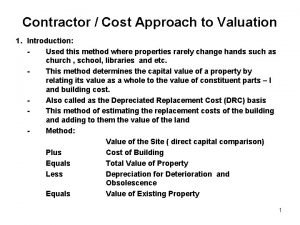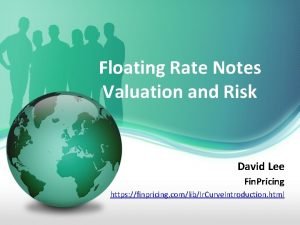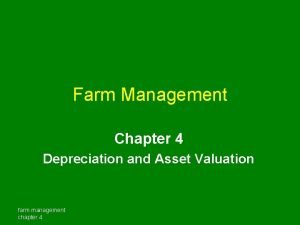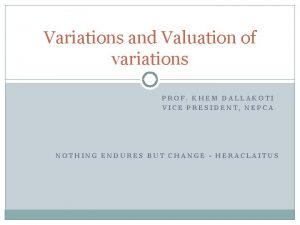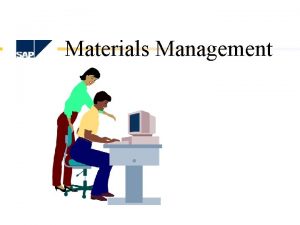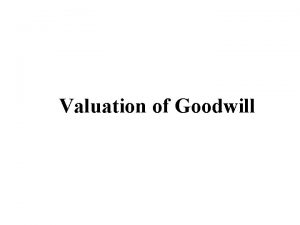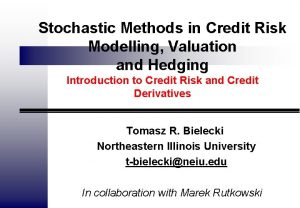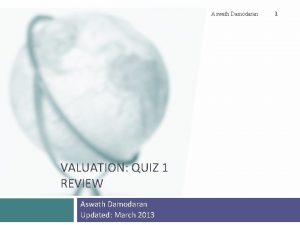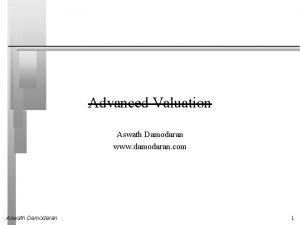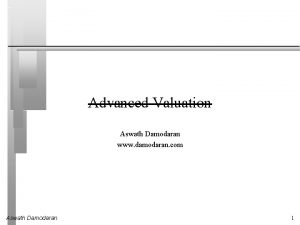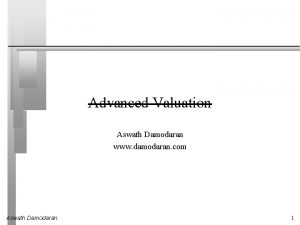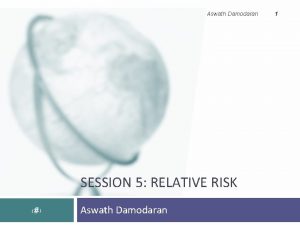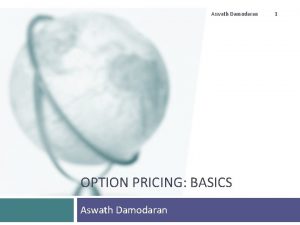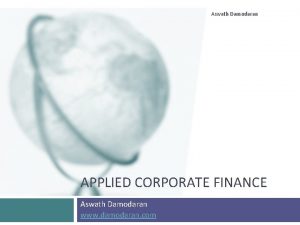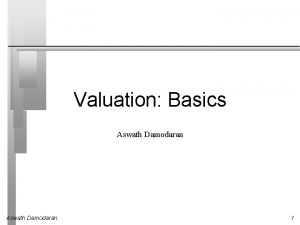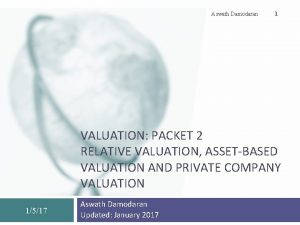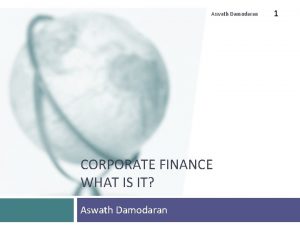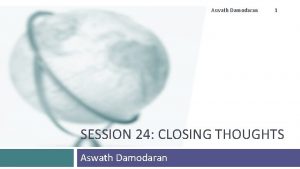Valuation Aswath Damodaran http www damodaran com Aswath





















































































- Slides: 85

Valuation Aswath Damodaran http: //www. damodaran. com Aswath Damodaran 1

Some Initial Thoughts " One hundred thousand lemmings cannot be wrong" Graffiti Aswath Damodaran 2

Misconceptions about Valuation � Myth 1: A valuation is an objective search for “true” value • • � Myth 2. : A good valuation provides a precise estimate of value • • � Truth 1. 1: All valuations are biased. The only questions are how much and in which direction. Truth 1. 2: The direction and magnitude of the bias in your valuation is directly proportional to who pays you and how much you are paid. Truth 2. 1: There are no precise valuations Truth 2. 2: The payoff to valuation is greatest when valuation is least precise. Myth 3: . The more quantitative a model, the better the valuation • • Aswath Damodaran Truth 3. 1: One’s understanding of a valuation model is inversely proportional to the number of inputs required for the model. Truth 3. 2: Simpler valuation models do much better than complex ones. 3

Approaches to Valuation � � � Discounted cashflow valuation, relates the value of an asset to the present value of expected future cashflows on that asset. Relative valuation, estimates the value of an asset by looking at the pricing of 'comparable' assets relative to a common variable like earnings, cashflows, book value or sales. Contingent claim valuation, uses option pricing models to measure the value of assets that share option characteristics. Aswath Damodaran 4

Discounted Cash Flow Valuation � � � What is it: In discounted cash flow valuation, the value of an asset is the present value of the expected cash flows on the asset. Philosophical Basis: Every asset has an intrinsic value that can be estimated, based upon its characteristics in terms of cash flows, growth and risk. Information Needed: To use discounted cash flow valuation, you need • • • � to estimate the life of the asset to estimate the cash flows during the life of the asset to estimate the discount rate to apply to these cash flows to get present value Market Inefficiency: Markets are assumed to make mistakes in pricing assets across time, and are assumed to correct themselves over time, as new information comes out about assets. Aswath Damodaran 5

Valuing a Firm � The value of the firm is obtained by discounting expected cashflows to the firm, i. e. , the residual cashflows after meeting all operating expenses and taxes, but prior to debt payments, at the weighted average cost of capital, which is the cost of the different components of financing used by the firm, weighted by their market value proportions. where, CF to Firmt = Expected Cashflow to Firm in period t WACC = Weighted Average Cost of Capital Aswath Damodaran 6

Aswath Damodaran 7

Aswath Damodaran 8

Aswath Damodaran 9

Aswath Damodaran 10

I. Discount Rates: Cost of Equity Aswath Damodaran 11

A Simple Test � o o o You are valuing a Greek company in Euros and are attempting to estimate a risk free rate to use in the analysis. The risk free rate that you should use is The interest rate on a nominal drachma-denominated Greek government bond The interest rate on a Euro-denominated Greek government bond (4. 11%) The interest rate on a Euro-denominated bond issued by the German government (3. 91%) Aswath Damodaran 12

Everyone uses historical premiums, but. . � � The historical premium is the premium that stocks have historically earned over riskless securities. Practitioners never seem to agree on the premium; it is sensitive to • • • How far back you go in history… Whether you use T. bill rates or T. Bond rates Whether you use geometric or arithmetic averages. For instance, looking at the US: Arithmetic average Geometric Average Stocks - Stocks Historical Period T. Bills T. Bonds T. Bills 1928 -2003 7. 92% 6. 54% 5. 99% 4. 82% 1963 -2003 6. 09% 4. 70% 4. 85% 3. 82% 1993 -2003 8. 43% 4. 87% 6. 68% 3. 57% � Aswath Damodaran T. Bonds 13

Assessing Country Risk Using Currency Ratings: Western Europe • • • • Country Austria Belgium Denmark Finland France. Aaa Germany Greece Ireland Italy Aa 3 Netherlands Norway Portugal Spain Aa 1 Sweden Switzerland Aswath Damodaran Rating Aaa Aaa 2 Aaa A 3 AA 2 12 Aaa A 3 9 Aa 1 Aaa Default Spread (in basis points) 0 9 16 4 0 20 10 3 0 14 50 0 14

Assessing Country Risk using Ratings: The Rest of Europe Country Rating Croatia Baa 3 Cyprus A 2 Czech Republic Hungary A 3 Latvia Baa 2 Lithuania Ba 1 Moldova B 3 Poland Baa 1 Romania B 3 Russia B 2 Slovakia Ba 1 Slovenia A 2 Turkey B 1 Aswath Damodaran Default Spread 145 90 Baa 1 120 95 130 250 650 120 650 550 250 90 450 15

Using Country Ratings to Estimate Equity Spreads � Country ratings measure default risk. While default risk premiums and equity risk premiums are highly correlated, one would expect equity spreads to be higher than debt spreads. • • One way to adjust the country spread upwards is to use information from the US market. In the US, the equity risk premium has been roughly twice the default spread on junk bonds. Another is to multiply the bond spread by the relative volatility of stock and bond prices in that market. For example, – Standard Deviation in Greek ASE(Equity) = 36% – Standard Deviation in Greek Euro Bond = 15% – Adjusted Equity Spread = 0. 20% (36/15) = 0. 48% Aswath Damodaran 16

From Country Spreads to Corporate Risk premiums � Approach 1: Assume that every company in the country is equally exposed to country risk. In this case, E(Return) = Riskfree Rate + Country Spread + Beta (US premium) Implicitly, this is what you are assuming when you use the local Government’s dollar borrowing rate as your riskfree rate. � � Approach 2: Assume that a company’s exposure to country risk is similar to its exposure to other market risk. E(Return) = Riskfree Rate + Beta (US premium + Country Spread) Approach 3: Treat country risk as a separate risk factor and allow firms to have different exposures to country risk (perhaps based upon the proportion of their revenues come from non-domestic sales) E(Return)=Riskfree Rate+ b (US premium) + l (Country Spread) Aswath Damodaran 17

Estimating Company Exposure to Country Risk � � � Different companies should be exposed to different degrees to country risk. For instance, a Greek firm that generates the bulk of its revenues in the rest of Western Europe should be less exposed to country risk than one that generates all its business within Greece. The factor “l” measures the relative exposure of a firm to country risk. One simplistic solution would be to do the following: l = % of revenues domesticallyfirm/ % of revenues domesticallyavg firm For instance, if a firm gets 35% of its revenues domestically while the average firm in that market gets 70% of its revenues domestically l = 35%/ 70 % = 0. 5 There are two implications • • Aswath Damodaran A company’s risk exposure is determined by where it does business and not by where it is located Firms might be able to actively manage their country risk exposures 18

Estimating E(Return) for Titan Cements Assume that the beta for Titan Cements is 0. 90, and that the riskfree rate used is 3. 91%. � Approach 1: Assume that every company in the country is equally exposed to country risk. In this case, E(Return) = 3. 91% + 0. 48% + 0. 90 (4. 53%) = 8. 47% � Approach 2: Assume that a company’s exposure to country risk is similar to its exposure to other market risk. E(Return) = 3. 91% + 0. 90 (4. 53%+ 0. 48%) = 8. 42% � Approach 3: Treat country risk as a separate risk factor and allow firms to have different exposures to country risk (perhaps based upon the proportion of their revenues come from non-domestic sales) E(Return)= 3. 91% + 0. 0(4. 53%) + 0. 56 (0. 48%) + 0. 05(3%) = 8. 41% Titan is less exposed to Greek country risk than the typical Greek firm since it gets about 40% of its revenues in Greece; the average for Greek firms is 70%. In 2001, though, Titan got about 5% of it’s revenues from the Baltic states. � Aswath Damodaran 19

Implied Equity Premium for the S&P 500: January 1, 2004 � We can use the information in stock prices to back out how risk averse the market is and how much of a risk premium it is demanding. � If you pay the current level of the index, you can expect to make a return of 7. 94% on stocks (which is obtained by solving for r in the following equation) � Implied Equity risk premium = Expected return on stocks - Treasury bond rate = 7. 94% - 4. 25% = 3. 69% Aswath Damodaran 20

Implied Premiums in the US Aswath Damodaran 21

Implied Premiums: From Bubble to Bear Market… January 2000 to December 2002 Aswath Damodaran 22

Effect of Changing Tax Status of Dividends on Stock Prices Expected Return on Stocks (Implied) in Jan 2003 = 7. 91% � Dividend Yield in January 2003 = 2. 00% � Assuming that dividends were taxed at 30% (on average) on 1/1/03 and that capital gains were taxed at 15%. � After-tax expected return on stocks = 2%(1 -. 3)+5. 91%(1 -. 15) = 6. 42% � If the tax rate on dividends drops to 15% and the after-tax expected return remains the same: 2% (1 -. 15) + X% (1 -. 15) = 6. 42% New Pre-tax required rate of return = 7. 56% New equity risk premium = 3. 75% Value of the S&P 500 at new equity risk premium = 965. 11 Expected Increase in index due to dividend tax change = 9. 69% � Aswath Damodaran 23

Choosing an Equity Risk Premium � � � The historical risk premium of 4. 82% for the United States is too high a premium to use in valuation. It is much higher than the actual implied equity risk premium in the market The current implied equity risk premium requires us to assume that the market is correctly priced today. (If I were required to be market neutral, this is the premium I would use) The average implied equity risk premium between 1960 -2001 in the United States is about 4%. We will use this as the premium for a mature equity market. Aswath Damodaran 24

Implied Premium for Greek Market: May 16, 2003 � � � Level of the Index = 1748 Dividends on the Index = 3. 53% of 1748 Other parameters • • Riskfree Rate = 3. 91% (Euros) Expected Growth (in Euros) – Next 5 years = 8% (Used expected growth rate in Earnings) – After year 5 = 3. 91% � Solving for the expected return: • • � Expected return on Equity = 8. 30% Implied Equity premium = 8. 30% - 3. 91% = 4. 39% Effect on valuation • • Aswath Damodaran Titan’s value with historical premium (4%) plus country (. 48%) : $ 49. 47 Tian’s value with implied premium: 47. 62 Euros per share 25

Estimating Beta � The standard procedure for estimating betas is to regress stock returns (Rj) against market returns (Rm) Rj = a + b Rm • � � where a is the intercept and b is the slope of the regression. The slope of the regression corresponds to the beta of the stock, and measures the riskiness of the stock. This beta has three problems: • • • Aswath Damodaran It has high standard error It reflects the firm’s business mix over the period of the regression, not the current mix It reflects the firm’s average financial leverage over the period rather than the current leverage. 26

Beta Estimation: Amazon Aswath Damodaran 27

Beta Estimation for Titan Cement: The Index Effect Aswath Damodaran 28

Determinants of Betas Aswath Damodaran 29

In a perfect world… we would estimate the beta of a firm by doing the following Aswath Damodaran 30

Bottom-up Betas Aswath Damodaran 31

Titan’s Bottom-up Beta Business Cement Unlevered D/E Ratio. 75 Levered beta 28. 23% 0. 90 Proportion of Value 100% Levered Beta = Unlevered Beta ( 1 + (1 - tax rate) (D/E Ratio) = 0. 75 ( 1 + (1 -. 3052) (. 2823)) = 0. 90 A Hypothetical scenario: Assume that Titan had been in two businesses- cement and construction. You could estimate a beta for the combined firm as follows Comparable firms Business Cement Construct. Firm Revenues 750 250 Value/Sales Unlevered beta 1. 33 0. 75 2. 00 1. 20 Value 1000 500 Weight 67% 33% Weight*Beta. 67*. 75. 33*1. 20 =. 95 Aswath Damodaran 32

Amazon’s Bottom-up Beta Unlevered beta for firms in internet retailing = Unlevered beta for firms in specialty retailing = � � 1. 60 1. 00 Amazon is a specialty retailer, but its risk currently seems to be determined by the fact that it is an online retailer. Hence we will use the beta of internet companies to begin the valuation By the fifth year, we are estimating substantial revenues for Amazon and we move the beta towards to beta of the retailing business. Aswath Damodaran 33

From Cost of Equity to Cost of Capital Aswath Damodaran 34

Estimating Synthetic Ratings � � � The rating for a firm can be estimated using the financial characteristics of the firm. In its simplest form, the rating can be estimated from the interest coverage ratio Interest Coverage Ratio = EBIT / Interest Expenses For Titan’s interest coverage ratio, we used the interest expenses and EBIT from 2002. Interest Coverage Ratio = 200. 6/ 28. 2 = 7. 14 Amazon. com has negative operating income; this yields a negative interest coverage ratio, which should suggest a low rating. We computed an average interest coverage ratio of 2. 82 over the next 5 years. Aswath Damodaran 35

Interest Coverage Ratios, Ratings and Default Spreads If Interest Coverage Ratio is Estimated Bond Rating Default Spread(1/00) Default Spread(1/03) > 8. 50 (>12. 50) AAA 0. 20% 0. 75% 6. 50 - 8. 50 (9. 5 -12. 5) AA 0. 50% 1. 00% 5. 50 - 6. 50 (7. 5 -9. 5) A+ 0. 80% 1. 50% 4. 25 - 5. 50 (6 -7. 5) A 1. 00% 1. 80% 3. 00 - 4. 25 (4. 5 -6) A– 1. 25% 2. 00% 2. 50 - 3. 00 (3. 5 -4. 5) BBB 1. 50% 2. 25% 2. 00 - 2. 50 ((3 -3. 5) BB 2. 00% 3. 50% 1. 75 - 2. 00 (2. 5 -3) B+ 2. 50% 4. 75% 1. 50 - 1. 75 (2 -2. 5) B 3. 25% 6. 50% 1. 25 - 1. 50 (1. 5 -2) B– 4. 25% 8. 00% 0. 80 - 1. 25 (1. 25 -1. 5) CCC 5. 00% 10. 00% 0. 65 - 0. 80 (0. 8 -1. 25) CC 6. 00% 11. 50% 0. 20 - 0. 65 (0. 5 -0. 8) C 7. 50% 12. 70% < 0. 20 (<0. 5) D 10. 00% 15. 00% For Titan, I used the interest coverage ratio table for smaller/riskier firms (the numbers in brackets) which yields a lower rating for the same interest coverage ratio. Aswath Damodaran 36

Estimating the cost of debt for a firm � � � The synthetic rating for Titan Cement is A. Using the 2003 default spread of 1. 80%, we estimate a cost of debt of 5. 91% (using a riskfree rate of 3. 91% and adding in the country default spread of 0. 20%): Cost of debt = Riskfree rate + Greek default spread + Company default spread =3. 91% + 0. . 20%+ 1. 80% = 5. 91% The synthetic rating for Amazon. com in 2000 was BBB. The default spread for BBB rated bond was 1. 50% in 2000 and the treasury bond rate was 6. 5%. Pre-tax cost of debt = Riskfree Rate + Default spread = 6. 50% + 1. 50% = 8. 00% The firm is paying no taxes currently. As the firm’s tax rate changes and its cost of debt changes, the after tax cost of debt will change as well. Pre-tax Tax rate 35% After-tax Aswath Damodaran 1 9 8. 00% 7. 67% 0% 35% 8. 00% 4. 98% 2 10 8. 00% 7. 50% 0% 35% 8. 00% 4. 88% 3 4 5 6 7 8. 00% 7. 00% 0% 8. 00% 7. 80% 7. 75% 16. 13% 35% 35% 8. 00% 4. 55% 6. 71% 5. 20% 5. 07% 5. 04% 8 37

Weights for the Cost of Capital Computation � � � The weights used to compute the cost of capital should be the market value weights for debt and equity. There is an element of circularity that is introduced into every valuation by doing this, since the values that we attach to the firm and equity at the end of the analysis are different from the values we gave them at the beginning. As a general rule, the debt that you should subtract from firm value to arrive at the value of equity should be the same debt that you used to compute the cost of capital. Aswath Damodaran 38

Estimating Cost of Capital: Amazon. com � Equity • • � Debt • • � Cost of Equity = 6. 50% + 1. 60 (4. 00%) = 12. 90% Market Value of Equity = $ 84/share* 340. 79 mil shs = $ 28, 626 mil (98. 8%) Cost of debt = 6. 50% + 1. 50% (default spread) = 8. 00% Market Value of Debt = $ 349 mil (1. 2%) Cost of Capital = 12. 9 % (. 988) + 8. 00% (1 - 0) (. 012)) = 12. 84% Aswath Damodaran 39

Estimating Cost of Capital: Titan Cements � Equity • • � Cost of Equity = 3. 91% + 0. 90 (4%+ 0. 48%) = 7. 94 % Market Value of Equity =1303 million Euros (78%) Debt • • Cost of debt = 3. 91% + 0. 20% +1. 80%= 5. 91% Market Value of Debt = 368 million Euros (22%) Cost of Capital = 7. 94 % (. 78) + 5. 91% (1 -. 3052) (0. 22)) = 7. 10% � The book value of equity at Titan Cement is 477 million Euros The book value of debt at Titan Cement is 361 million; Interest expense is 28 mil; Average maturity of debt = 4 years Estimated market value of debt = 28 million (PV of annuity, 4 years, 5. 91%) + $361 million/1. 05914 = $368 million Aswath Damodaran 40

II. Estimating Cash Flows to Firm Aswath Damodaran 41

The Importance of Updating The operating income and revenue that we use in valuation should be updated numbers. One of the problems with using financial statements is that they are dated. � As a general rule, it is better to use 12 -month trailing estimates for earnings and revenues than numbers for the most recent financial year. This rule becomes even more critical when valuing companies that are evolving and growing rapidly. Last 10 -KTrailing 12 -month Revenues $ 610 million $1, 117 million EBIT - $125 million - $ 410 million � The valuation of Titan is dated because there have been no financial statements released since the last 10 K. � Aswath Damodaran 42

Normalizing Earnings: Amazon Year Tr 12 m 1 2 3 4 5 6 7 8 9 10 TY(11) Aswath Damodaran Revenues $1, 117 -36. 71% $2, 793 -13. 35% $5, 585 -1. 68% $9, 774 4. 16% $14, 661 7. 08% $19, 059 8. 54% $23, 862 9. 27% $28, 729 9. 64% $33, 211 9. 82% $36, 798 9. 91% $39, 006 9. 95% $41, 346 10. 00% Operating Margin EBIT -$410 -$373 -$94 $407 $1, 038 $1, 628 $2, 212 $2, 768 $3, 261 $3, 646 $3, 883 $4, 135 Industry Average 43

Operating Leases at The Home Depot in 1998 � The pre-tax cost of debt at the Home Depot is 6. 25% Yr 1 2 3 4 5 6 -15 � Operating Lease Expense Present Value $ 294 $ 277 $ 291 $ 258 $ 264 $ 220 $ 245 $ 192 $ 236 $ 174 $ 270 $ 1, 450 (PV of 10 -yr annuity) Present Value of Operating Leases =$ 2, 571 Debt outstanding at the Home Depot = $1, 205 + $2, 571 = $3, 776 mil (The Home Depot has other debt outstanding of $1, 205 million) � Adjusted Operating Income = $2, 016 + 2, 571 (. 0625) = $2, 177 mil Aswath Damodaran 44

Capitalizing R&D Expenses: Shire Pharmaceuticals � To capitalize R&D, • • • Specify an amortizable life for R&D (2 - 10 years) Collect past R&D expenses for as long as the amortizable life Sum up the unamortized R&D over the period. (Thus, if the amortizable life is 5 years, the research asset can be obtained by adding up 1/5 th of the R&D expense from five years ago, 2/5 th of the R&D expense from four years ago. . . : R & D was assumed to have a 5 -year life. Year R&D Unamortized R&D Current £ 48. 12 1. 00 £ 48. 12 -1 £ 37. 42 0. 80 £ 29. 94 -2 £ 28. 99 0. 60 £ 17. 39 -3 £ 17. 88 0. 40 £ 7. 15 -4 £ 8. 18 0. 20 £ 1. 64 -5 £ 4. 56 0. 00 £ 0. 00 � Amortization £ 0. 00 £ 7. 48 £ 5. 80 £ 3. 58 £ 1. 64 £ 0. 91 £ 104. 24 £ 19. 41 Value of research asset = £ 104. 24 Amortization of research asset in 2000 = £ 19. 41 Adjustment to Operating Income = + R&D - Amortization of R&D Adjusted Operating Income = £ 41. 03 + £ 48. 12 - £ 19. 41 = £ 69. 74 Aswath Damodaran 45

The Effect of Net Operating Losses: Amazon. com’s Tax Rate Year 1 EBIT -$373 Taxes $0 EBIT(1 -t)-$373 Tax rate 0% NOL $500 2 3 4 5 -$94 $0 -$94 0% $873 $407 $0 $407 0% $967 $1, 038 $167 $871 16. 13% $560 $1, 628 $570 $1, 058 35% $0 After year 5, the tax rate becomes 35%. Aswath Damodaran 46

Estimating Actual FCFF: Titan Cement EBIT = 200. 6 million Euros � Tax rate = 30. 52% � Net Capital expenditures = Cap Ex - Depreciation = 113. 3 - 80. 9 = 32. 4 million � Change in Working Capital = -10. 6 million Estimating FCFF (2000) Current EBIT * (1 - tax rate) = 200. 6 (1 -. 3052) = 139. 4 Million - (Capital Spending - Depreciation) 32. 4 - Change in Working Capital (10. 6) Current FCFF 117. 6 Million Euros � Aswath Damodaran 47

Estimating FCFF: Amazon. com � � � EBIT (Trailing 1999) = -$ 410 million Tax rate used = 0% (Assumed Effective = Marginal) Capital spending (Trailing 1999) = $ 243 million Depreciation (Trailing 1999) = $ 31 million Non-cash Working capital Change (1999) = - 80 million Estimating FCFF (1999) Current EBIT * (1 - tax rate) = - 410 (1 -0) - (Capital Spending - Depreciation) - Change in Working Capital Current FCFF Aswath Damodaran = - $410 million = $212 million = -$ 80 million = - $542 million 48

IV. Expected Growth in EBIT and Fundamentals � � � Reinvestment Rate and Return on Capital g. EBIT = (Net Capital Expenditures + Change in WC)/EBIT(1 -t) * ROC = Reinvestment Rate * ROC Proposition: No firm can expect its operating income to grow over time without reinvesting some of the operating income in net capital expenditures and/or working capital. Proposition: The net capital expenditure needs of a firm, for a given growth rate, should be inversely proportional to the quality of its investments. Aswath Damodaran 49

Normalizing Reinvestment: Titan Cements Aswath Damodaran 50

Expected Growth Estimate: Titan Cement � � Normalized Change in working capital = (Working capital as percent of revenues) * Change in revenues in 2002 =. 144 (1036 -983) = 7. 03 mil Euros Normalized Net Cap Ex = Net Cap ex as % of EBIT(1 -t) * EBIT (1 -t) in 2001 =. 2754*(200. 6(1 -. 3052)) = 32. 36 million Euros Normalized reinvestment rate = (32. 36+7. 03)/(200. 6(1 -. 3052)) = 33. 04% Return on capital = 200. 6 (1 -. 3052)/ (458+390) = 16. 43% • � The book value of debt and equity from last year was used. Expected growth rate =. 3304*. 1643 = 5. 43% Aswath Damodaran 51

Revenue Growth and Operating Margins With negative operating income and a negative return on capital, the fundamental growth equation is of little use for Amazon. com � For Amazon, the effect of reinvestment shows up in revenue growth rates and changes in expected operating margins: Expected Revenue Growth in $ = Reinvestment (in $ terms) * (Sales/ Capital) � The effect on expected margins is more subtle. Amazon’s reinvestments (especially in acquisitions) may help create barriers to entry and other competitive advantages that will ultimately translate into high operating margins and high profits. � Aswath Damodaran 52

Growth in Revenues, Earnings and Reinvestment: Amazon Year Revenue ROC Growth 1 150. 00% 2 100. 00% 3 75. 00% $4, 189 4 50. 00% $4, 887 5 30. 00% $4, 398 6 25. 20% $4, 803 7 20. 40% $4, 868 8 15. 60% $4, 482 9 10. 80% $3, 587 10 6. 00% $2, 208 Chg in Reinvestment Chg Rev/ Chg Reinvestment Revenue $1, 676 $2, 793 $1, 396 $1, 629 $1, 466 $1, 601 $1, 623 $1, 494 $1, 196 $736 $559 $931 3. 00 3. 00 -76. 62% -8. 96% 3. 00 20. 59% 25. 82% 21. 16% 22. 23% 22. 30% 21. 87% 21. 19% 20. 39% Assume that firm can earn high returns because of established economies of scale. Aswath Damodaran 53

V. Growth Patterns � A key assumption in all discounted cash flow models is the period of high growth, and the pattern of growth during that period. In general, we can make one of three assumptions: • • • there is no high growth, in which case the firm is already in stable growth there will be high growth for a period, at the end of which the growth rate will drop to the stable growth rate (2 -stage) there will be high growth for a period, at the end of which the growth rate will decline gradually to a stable growth rate(3 -stage) Stable Growth Aswath Damodaran 2 -Stage Growth 3 -Stage Growth 54

Determinants of Growth Patterns � Size of the firm • � Current growth rate • � Success usually makes a firm larger. As firms become larger, it becomes much more difficult for them to maintain high growth rates While past growth is not always a reliable indicator of future growth, there is a correlation between current growth and future growth. Thus, a firm growing at 30% currently probably has higher growth and a longer expected growth period than one growing 10% a year now. Barriers to entry and differential advantages • • Aswath Damodaran Ultimately, high growth comes from high project returns, which, in turn, comes from barriers to entry and differential advantages. The question of how long growth will last and how high it will be can therefore be framed as a question about what the barriers to entry are, how long they will stay up and how strong they will remain. 55

Stable Growth Characteristics � In stable growth, firms should have the characteristics of other stable growth firms. In particular, • The risk of the firm, as measured by beta and ratings, should reflect that of a stable growth firm. – Beta should move towards one – The cost of debt should reflect the safety of stable firms (BBB or higher) • The debt ratio of the firm might increase to reflect the larger and more stable earnings of these firms. – The debt ratio of the firm might moved to the optimal or an industry average – If the managers of the firm are deeply averse to debt, this may never happen • The reinvestment rate of the firm should reflect the expected growth rate and the firm’s return on capital – Reinvestment Rate = Expected Growth Rate / Return on Capital Aswath Damodaran 56

Titan and Amazon. com: Stable Growth Inputs � � High Growth Titan Cement • • • � Beta 0. 90 Debt Ratio 22. 02% Return on Capital Cost of Capital Expected Growth Rate Reinvestment Rate Stable Growth 1. 00 22. 02% 16. 43% 7. 10% 5. 43% 33. 04% 7. 01% 3. 91%/7. 01% = 55. 77% Amazon. com • • • Aswath Damodaran Beta 1. 60 Debt Ratio 1. 20% Return on Capital Expected Growth Rate Reinvestment Rate 1. 00 15% Negative 20% NMF 6% >100% 6%/20% = 30% 57

Dealing with Cash and Marketable Securities � � The simplest and most direct way of dealing with cash and marketable securities is to keep them out of the valuation - the cash flows should be before interest income from cash and securities, and the discount rate should not be contaminated by the inclusion of cash. (Use betas of the operating assets alone to estimate the cost of equity). Once the firm has been valued, add back the value of cash and marketable securities. • Aswath Damodaran If you have a particularly incompetent management, with a history of overpaying on acquisitions, markets may discount the value of this cash. 58

Dealing with Cross Holdings � � � When the holding is a majority, active stake, the value that we obtain from the cash flows includes the share held by outsiders. While their holding is measured in the balance sheet as a minority interest, it is at book value. To get the correct value, we need to subtract out the estimated market value of the minority interests from the firm value. When the holding is a minority, passive interest, the problem is a different one. The firm shows on its income statement only the share of dividends it receives on the holding. Using only this income will understate the value of the holdings. In fact, we have to value the subsidiary as a separate entity to get a measure of the market value of this holding. Proposition 1: It is almost impossible to correctly value firms with minority, passive interests in a large number of private subsidiaries. Aswath Damodaran 59

Titan’s Cash and Cross Holdings � � Titan has a majority interest in another company and the financial statements of that company are consolidated with those of Titan. The minority interests (representing the equity in the subsidiary that does not belong to Titan) are shown on the balance sheet at 47. 40 million Euros. Estimated market value of minority interests = Book value of minority interest * P/BV of sector that subsidiary belongs to = 47. 40 * 2. 5 = 118. 5 million Present value of FCFF for high growth period = + Present Value of Terminal Value = Value of Operating Assets of Firm + Cash and Marketable Securities + Minority Interests in other companies = = Value of Firm - Minority Interests in Consolidated companies - Debt = Value of Equity Aswath Damodaran 445. 3 1841. 7 2287. 0 85. 8 0. 0 2372. 8 118. 5 367. 7 1886. 6 60

Amazon: Estimating the Value of Equity Options � Details of options outstanding • • � Average strike price of options outstanding = Average maturity of options outstanding = Standard deviation in ln(stock price) = Annualized dividend yield on stock = Treasury bond rate = Number of options outstanding = Number of shares outstanding = $ 13. 375 8. 4 years 50. 00% 6. 50% 38 million 340. 79 million Value of options outstanding (using dilution-adjusted Black-Scholes model) • Aswath Damodaran Value of equity options = $ 2, 892 million 61

Aswath Damodaran 62

Amazon. com: Break Even at $84? Aswath Damodaran 63

Aswath Damodaran 64

Aswath Damodaran 65

Value Enhancement: Back to Basics Aswath Damodaran http: //www. damodaran. com Aswath Damodaran 66

Price Enhancement versus Value Enhancement Aswath Damodaran 67

The Paths to Value Creation � Using the DCF framework, there are four basic ways in which the value of a firm can be enhanced: • The cash flows from existing assets to the firm can be increased, by either – increasing after-tax earnings from assets in place or – reducing reinvestment needs (net capital expenditures or working capital) • The expected growth rate in these cash flows can be increased by either – Increasing the rate of reinvestment in the firm – Improving the return on capital on those reinvestments • • The length of the high growth period can be extended to allow for more years of high growth. The cost of capital can be reduced by – Reducing the operating risk in investments/assets – Changing the financial mix – Changing the financing composition Aswath Damodaran 68

A Basic Proposition � For an action to affect the value of the firm, it has to • • � Affect current cash flows (or) Affect future growth (or) Affect the length of the high growth period (or) Affect the discount rate (cost of capital) Proposition 1: Actions that do not affect current cash flows, future growth, the length of the high growth period or the discount rate cannot affect value. Aswath Damodaran 69

Value-Neutral Actions � � Stock splits and stock dividends change the number of units of equity in a firm, but cannot affect firm value since they do not affect cash flows, growth or risk. Accounting decisions that affect reported earnings but not cash flows should have no effect on value. • • � Changing inventory valuation methods from FIFO to LIFO or vice versa in financial reports but not for tax purposes Changing the depreciation method used in financial reports (but not the tax books) from accelerated to straight line depreciation Major non-cash restructuring charges that reduce reported earnings but are not tax deductible Using pooling instead of purchase in acquisitions cannot change the value of a target firm. Decisions that create new securities on the existing assets of the firm (without altering the financial mix) such as tracking stock cannot create value, though they might affect perceptions and hence the price. Aswath Damodaran 70

I. Ways of Increasing Cash Flows from Assets in Place Aswath Damodaran 71

II. Value Enhancement through Growth Aswath Damodaran 72

III. Building Competitive Advantages: Increase length of the growth period Aswath Damodaran 73

3. 1: The Brand Name Advantage � � Some firms are able to sustain above-normal returns and growth because they have well-recognized brand names that allow them to charge higher prices than their competitors and/or sell more than their competitors. Firms that are able to improve their brand name value over time can increase both their growth rate and the period over which they can expect to grow at rates above the stable growth rate, thus increasing value. Aswath Damodaran 74

Illustration: Valuing a brand name: Coca Cola Generic Cola Company AT Operating Margin 18. 56% 7. 50% Sales/BV of Capital 1. 67 ROC 31. 02% 12. 53% Reinvestment Rate 65. 00% (19. 35%) 65. 00% (47. 90%) Expected Growth 20. 16% 8. 15% Length 10 years 10 yea Cost of Equity 12. 33% E/(D+E) 97. 65% AT Cost of Debt 4. 16% D/(D+E) 2. 35% Cost of Capital 12. 13% Value $115 $13 Aswath Damodaran 75

3. 2: Patents and Legal Protection � � � The most complete protection that a firm can have from competitive pressure is to own a patent, copyright or some other kind of legal protection allowing it to be the sole producer for an extended period. Note that patents only provide partial protection, since they cannot protect a firm against a competitive product that meets the same need but is not covered by the patent protection. Licenses and government-sanctioned monopolies also provide protection against competition. They may, however, come with restrictions on excess returns; utilities in the United States, for instance, are monopolies but are regulated when it comes to price increases and returns. Aswath Damodaran 76

3. 3: Switching Costs � � � Another potential barrier to entry is the cost associated with switching from one firm’s products to another. The greater the switching costs, the more difficult it is for competitors to come in and compete away excess returns. Firms that devise ways to increase the cost of switching from their products to competitors’ products, while reducing the costs of switching from competitor products to their own will be able to increase their expected length of growth. Aswath Damodaran 77

3. 4: Cost Advantages � There a number of ways in which firms can establish a cost advantage over their competitors, and use this cost advantage as a barrier to entry: • • • � In businesses, where scale can be used to reduce costs, economies of scale can give bigger firms advantages over smaller firms Owning or having exclusive rights to a distribution system can provide firms with a cost advantage over its competitors. Owning or having the rights to extract a natural resource which is in restricted supply (The undeveloped reserves of an oil or mining company, for instance) These cost advantages will show up in valuation in one of two ways: • • Aswath Damodaran The firm may charge the same price as its competitors, but have a much higher operating margin. The firm may charge lower prices than its competitors and have a much higher capital turnover ratio. 78

Gauging Barriers to Entry � p p p p Which of the following barriers to entry are most likely to work for Titan Cement? Brand Name Patents and Legal Protection Switching Costs Cost Advantages What about for Amazon. com? Brand Name Patents and Legal Protection Switching Costs Cost Advantages Aswath Damodaran 79

Reducing Cost of Capital Aswath Damodaran 80

Amazon. com: Optimal Debt Ratio Aswath Damodaran 81

Titan : Optimal Capital Structure Aswath Damodaran 82

Aswath Damodaran 83

The Value of Control? � � � If the value of a firm run optimally is significantly higher than the value of the firm with the status quo (or incumbent management), you can write the value that you should be willing to pay as: Value of control = Value of firm optimally run - Value of firm with status quo Implications: • • • The value of control is greatest at poorly run firms. Voting shares in poorly run firms should trade at a premium on non-voting shares if the votes associated with the shares will give you a chance to have a say in a hostile acquisition. When valuing private firms, your estimate of value will vary depending upon whether you gain control of the firm. For example, 49% of a private firm may be worth less than 51% of the same firm. 49% stake = 49% of status quo value 51% stake = 51% of optimal value Aswath Damodaran 84

Back to Lemmings. . . Aswath Damodaran 85
 Aswath damodaran
Aswath damodaran Cơm
Cơm Dậy thổi cơm mua thịt cá
Dậy thổi cơm mua thịt cá Aswath damodaran ebitda
Aswath damodaran ebitda Aswath damodaran erp
Aswath damodaran erp Aswath damodaran personal portfolio
Aswath damodaran personal portfolio Data damodaran
Data damodaran Aswath damodaran accounting
Aswath damodaran accounting Damodaran
Damodaran Multiples damodaran
Multiples damodaran Dcf aswath
Dcf aswath Aswath damodaran intrinsic value
Aswath damodaran intrinsic value Aswath damodaran age
Aswath damodaran age Damodaran value investing
Damodaran value investing Damodaran relative valuation
Damodaran relative valuation Aswath damodaran
Aswath damodaran Aswath damodaran esg
Aswath damodaran esg Aswath damodaran net worth
Aswath damodaran net worth Damodaran
Damodaran Aswath damodaran value investing
Aswath damodaran value investing Default spread risk free rate
Default spread risk free rate Damodarans
Damodarans Risk free rate aswath damodaran
Risk free rate aswath damodaran Aswath damodaran multiples
Aswath damodaran multiples Damodaran statistics
Damodaran statistics Aswath damodaran discount rate
Aswath damodaran discount rate Quiz
Quiz Aswath damodaran discount rate
Aswath damodaran discount rate Types of investment philosophies
Types of investment philosophies Damodaran portfolio
Damodaran portfolio Aswath damodaran portfolio
Aswath damodaran portfolio Damodaran
Damodaran Damodaran credit spread
Damodaran credit spread Aswath damodaran value investing
Aswath damodaran value investing Aswath damodaran intrinsic value
Aswath damodaran intrinsic value Valuation of fixed income securities
Valuation of fixed income securities Relative valuation
Relative valuation Damodaran private company valuation
Damodaran private company valuation Http://www.damodaran.com
Http://www.damodaran.com Http //mbs.meb.gov.tr/ http //www.alantercihleri.com
Http //mbs.meb.gov.tr/ http //www.alantercihleri.com Http //siat.ung.ac.id atau http //pmb.ung.ac.id
Http //siat.ung.ac.id atau http //pmb.ung.ac.id Dcf aswath
Dcf aswath How to find the price of a bond
How to find the price of a bond Contingent valuation method
Contingent valuation method Preferred stock valuation
Preferred stock valuation 7 principles of valuation
7 principles of valuation Equity analysis and valuation
Equity analysis and valuation Equity valuation ppt
Equity valuation ppt Sum-of-the-parts valuation
Sum-of-the-parts valuation Spirit of arun
Spirit of arun Importance of equity valuation
Importance of equity valuation Approaches of assessment
Approaches of assessment Swapd fees calculator
Swapd fees calculator Revealed preference methods of environmental valuation
Revealed preference methods of environmental valuation Arrcus valuation
Arrcus valuation Trade secret valuation
Trade secret valuation Skillshare valuation
Skillshare valuation Fixed income valuation
Fixed income valuation Livestock valuation methods
Livestock valuation methods Single stage residual income model
Single stage residual income model Ivs framework
Ivs framework Ropi valuation model
Ropi valuation model Tableau valuation
Tableau valuation Why fibonacci series is used in agile
Why fibonacci series is used in agile Gas station appraisal sample
Gas station appraisal sample Security valuation process
Security valuation process Football field valuation chart
Football field valuation chart Common stock valuation examples
Common stock valuation examples Bilateral cva
Bilateral cva Chapter 6 interest rates and bond valuation
Chapter 6 interest rates and bond valuation Venture capital method valuation
Venture capital method valuation Mvs 6
Mvs 6 Registered valuer securities or financial assets
Registered valuer securities or financial assets Griffiths valuation map
Griffiths valuation map Drc method of valuation
Drc method of valuation Floating rate note valuation
Floating rate note valuation Contingent valuation method
Contingent valuation method Valuation of farm assets
Valuation of farm assets Asset backing method of valuation of shares
Asset backing method of valuation of shares Valuation of variations
Valuation of variations Peer group valuation
Peer group valuation Gr/ir clearing
Gr/ir clearing Sliding scale valuation method
Sliding scale valuation method Credit valuation adjustment
Credit valuation adjustment Chapter 7 interest rates and bond valuation
Chapter 7 interest rates and bond valuation Commonbond valuation
Commonbond valuation



